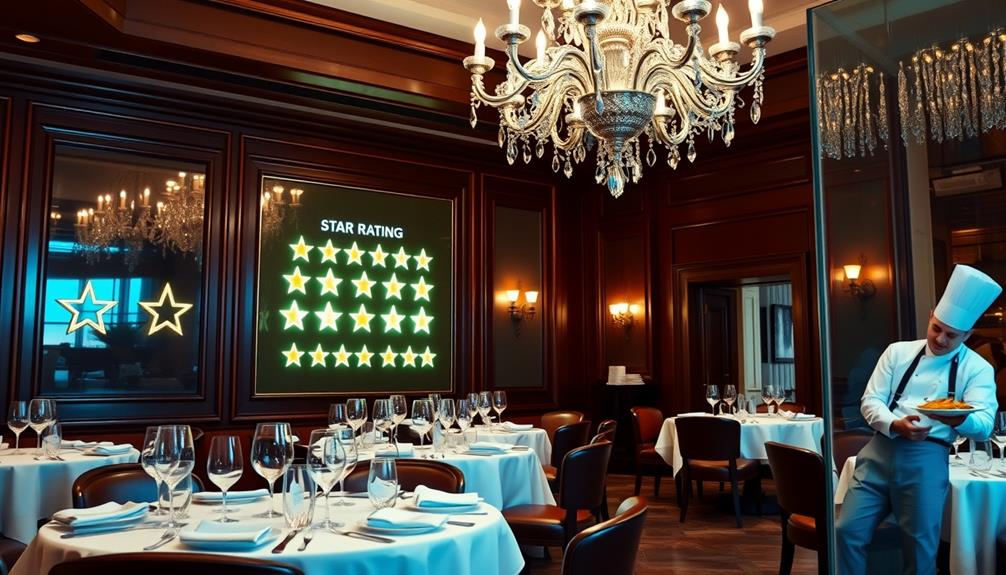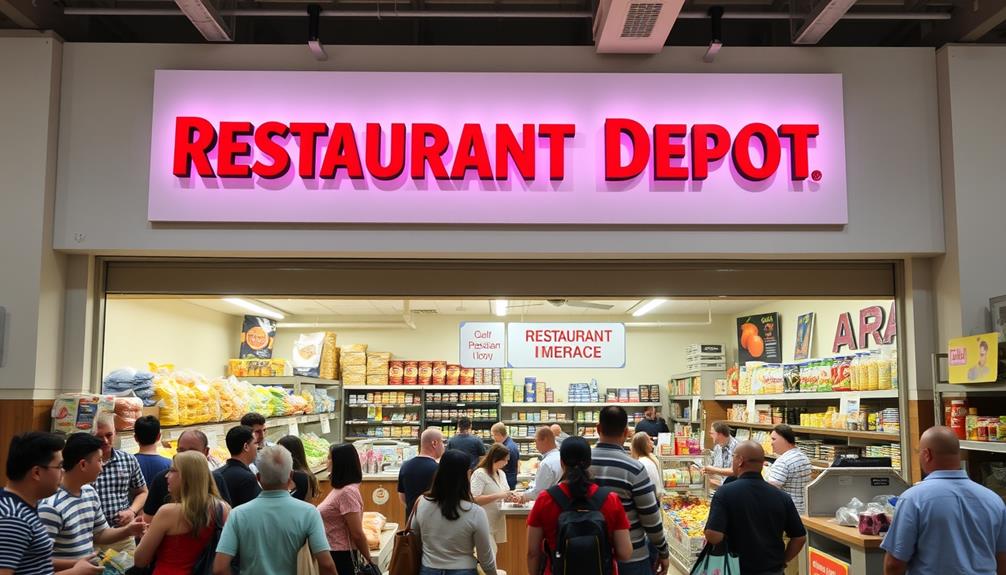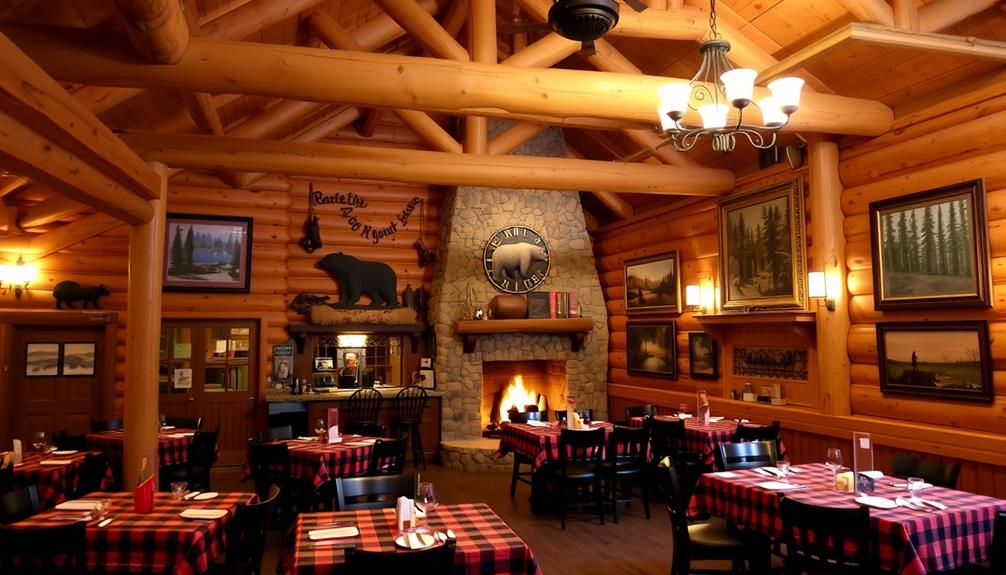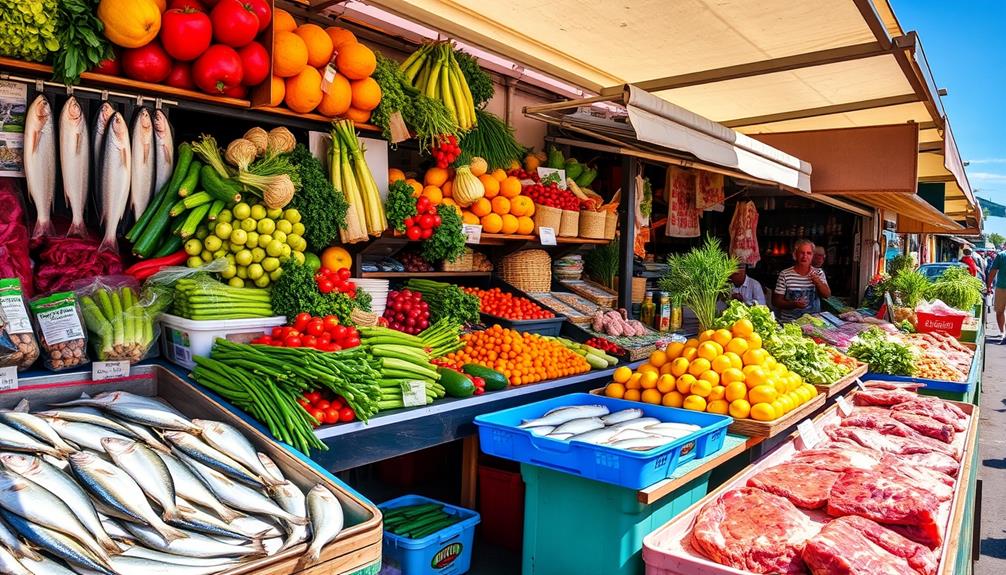A restaurant can earn anywhere from zero to three Michelin stars. One star means it's a very good restaurant. Two stars signify excellent cooking that's worth a detour. If a restaurant has three stars, it's exceptional cuisine worth a special journey. As of 2024, only 145 restaurants globally hold this prestigious three-star rating, highlighting the fierce competition in the culinary world. The Michelin Guide updates its ratings annually, so restaurants can gain or lose stars based on consistent performance. Curious about what it takes to earn these stars? There's more to discover about the Michelin rating process.
Key Takeaways
- Restaurants can earn up to three Michelin stars, indicating varying levels of culinary excellence.
- One star denotes a very good restaurant; two stars indicate excellent cooking worth a detour.
- Three stars signify exceptional cuisine worth a special journey and are rare, with only 145 globally.
- Most restaurants rated by the Michelin Guide earn zero stars, highlighting the high standards required for recognition.
- The star rating system promotes continuous excellence, as restaurants can gain or lose stars annually based on performance.
Overview of Michelin Stars
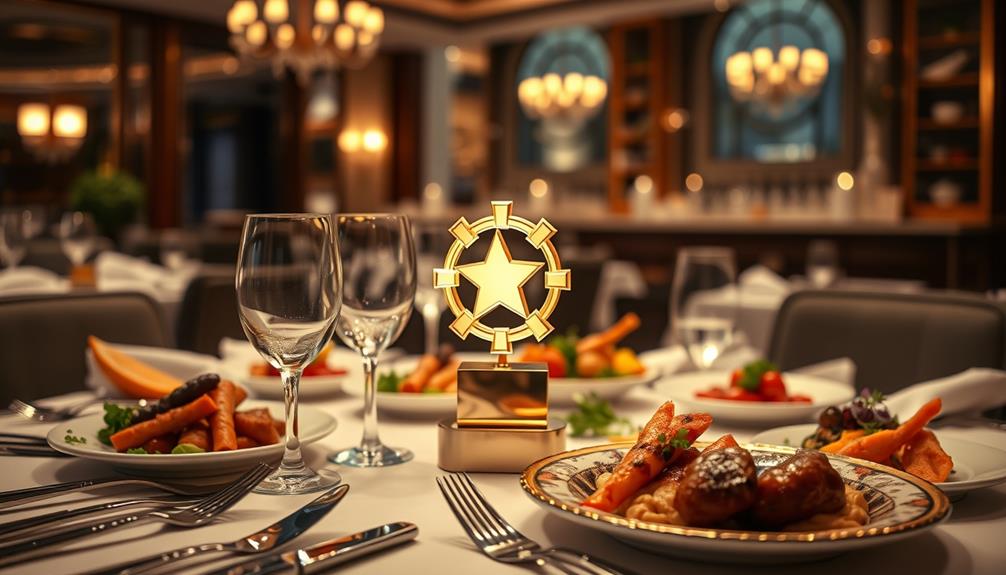
When it comes to Michelin stars, a restaurant can earn up to three prestigious accolades that signify its culinary excellence. The star rating system, established in 1926 and expanded to include three Michelin stars in 1931, serves as a benchmark for quality in the dining world.
Each star represents a different level of achievement: one star indicates a very good restaurant, two stars suggest excellent cooking worth a detour, and three stars signify exceptional cuisine worth a special journey. This competitive landscape is akin to the importance of maintaining a strong credit score for financial health, as both require consistent effort and dedication to achieve remarkable results.
As of 2024, only 145 restaurants globally have been awarded three Michelin stars, highlighting the fierce competition in the culinary landscape. Most establishments rated by the Michelin Guide earn zero stars, making the quest for Michelin recognition even more challenging.
The Guide publishes annual updates on star ratings, meaning restaurants can gain or lose stars based on their performance each year. This dynamic nature of the Michelin star system guarantees that chefs continuously endeavor for excellence, knowing that their status can change.
Ultimately, achieving Michelin stars is a proof of a restaurant's commitment to exceptional cuisine and service, making it a coveted goal for culinary professionals around the world.
History of the Michelin Guide
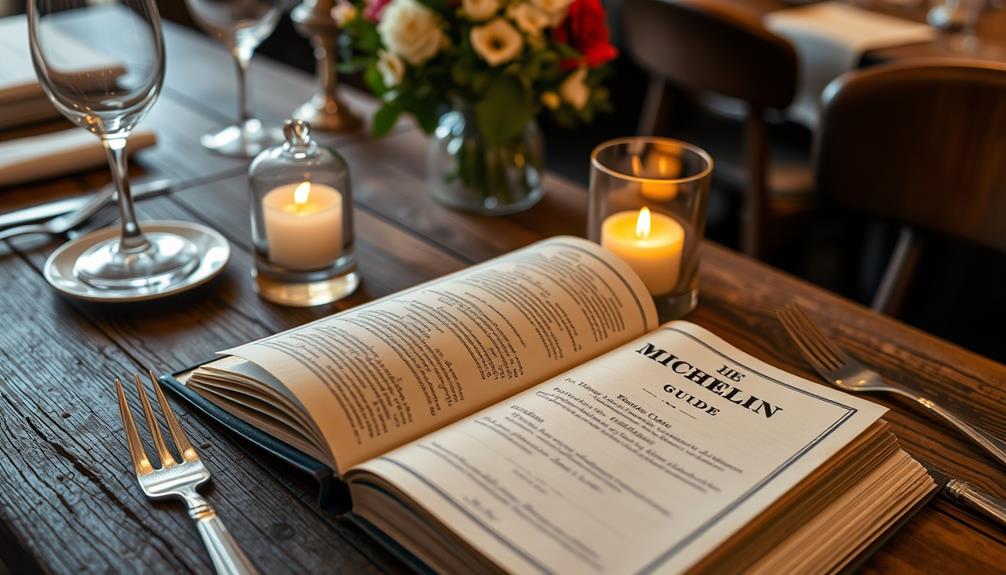
The Michelin Guide has a rich history that began in 1900, created by the Michelin tire company to promote automobile travel and boost tire sales. Initially, it provided maps and restaurant listings, encouraging people to hit the road.
The star rating system was introduced in 1926, with the first stars awarded to restaurants. This innovative approach set the stage for what would evolve into the revered three-star system in 1931, which remains the pinnacle of culinary excellence today. Remarkably, the guide not only highlights fine dining but also emphasizes diverse culinary experiences, much like the natural wonders and outdoor activities found in various states across the country.
As the years went by, the Michelin Guide expanded beyond France, now covering 37 countries across Europe, Asia, and the Americas. The origins of the Michelin Guide reflect a desire to recognize not just French cuisine but diverse culinary styles and global cuisines. This evolution mirrors changing dining trends and standards, adapting to what food enthusiasts crave.
Later editions introduced the Bib Gourmand and Michelin Plate, showcasing quality dining experiences that go beyond starred restaurants. These additions demonstrate the guide's commitment to celebrating the full spectrum of culinary talent.
Understanding the history of the Michelin Guide helps you appreciate the significance of its stars in the world of gastronomy.
Michelin Inspection Process
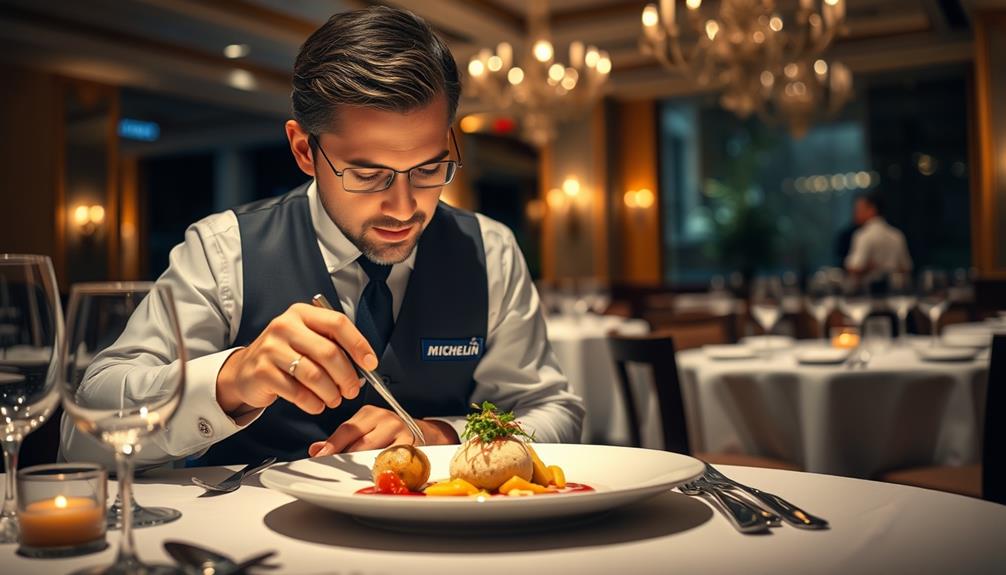
Michelin's inspection process is a meticulous and rigorous evaluation that guarantees only the finest restaurants receive stars. With a team of 80 anonymous inspectors, Michelin ascertains that restaurants are assessed fairly across various times and seasons. Each inspector conducts multiple visits, focusing on key elements that define culinary excellence.
| Criterion | Description | Importance |
|---|---|---|
| Quality of Ingredients | Freshness and sourcing of ingredients | Fundamental to flavor |
| Mastery of Cooking Techniques | Skills and techniques used by chefs | Reflects training and expertise |
| Chef's Personality | Unique touches in the cuisine | Adds character to the dining experience |
| Value for Money | Quality relative to pricing | Guarantees a worthwhile experience |
| Consistency of Food Quality | Uniformity across visits | Essential for reliable dining |
The inspection process evaluates these criteria to determine star ratings: one star for very good, two stars for excellent cooking worth a detour, and three stars for exceptional cuisine worth a special journey. The review cycle occurs 18 months after a restaurant's first star, reflecting Michelin's commitment to maintaining high standards.
Criteria for Awarding Stars
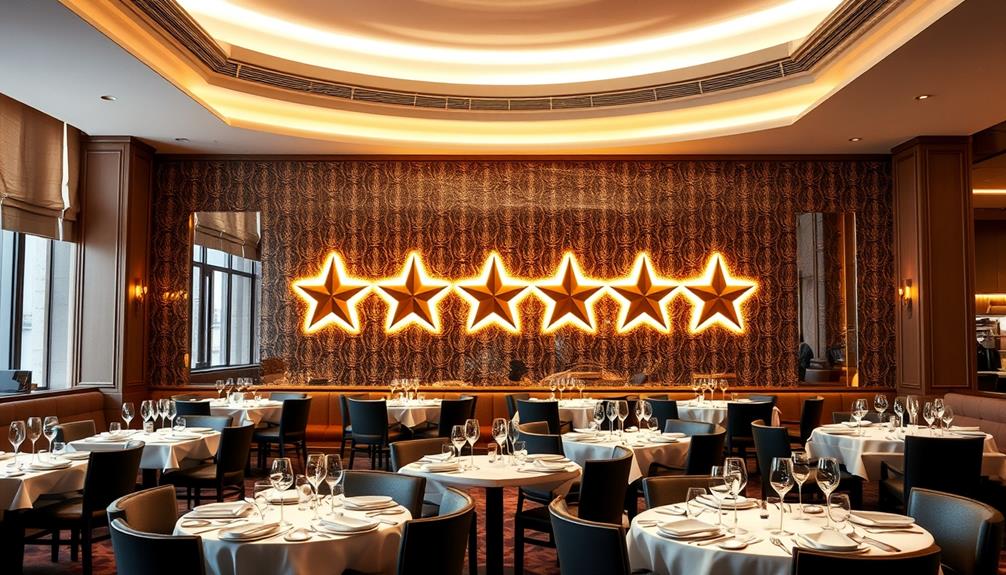
Evaluating a restaurant's culinary prowess involves several key criteria that determine whether it earns a Michelin star. Michelin Star Restaurants are judged rigorously, focusing solely on the food rather than the decor or service.
In addition to the culinary expertise, the restaurant's approach to sourcing ingredients ethically can also enhance its appeal to discerning diners, reflecting a growing trend in the industry ethical sourcing practices.
Here are the five main criteria that inspectors consider:
- Quality of ingredients: The freshness and provenance of the ingredients play a fundamental role.
- Cooking techniques: Mastery in preparation and cooking methods showcases a chef's skill.
- Personality of the chef: The unique touch and creativity of the chef must shine through in the dishes.
- Consistency of food quality: Every dish served should meet the same high standards, regardless of when or how often you visit.
- Value for money: While not a primary focus, a restaurant must still offer an experience that justifies its price.
Each restaurant can earn up to three stars, indicating varying levels of culinary excellence.
Remember, stars are reassessed annually, so maintaining these criteria is essential for any establishment aiming to keep its Michelin status.
Ultimately, the emphasis remains on culinary achievement, ensuring that diners experience the best the culinary world has to offer.
Impact of Michelin Stars
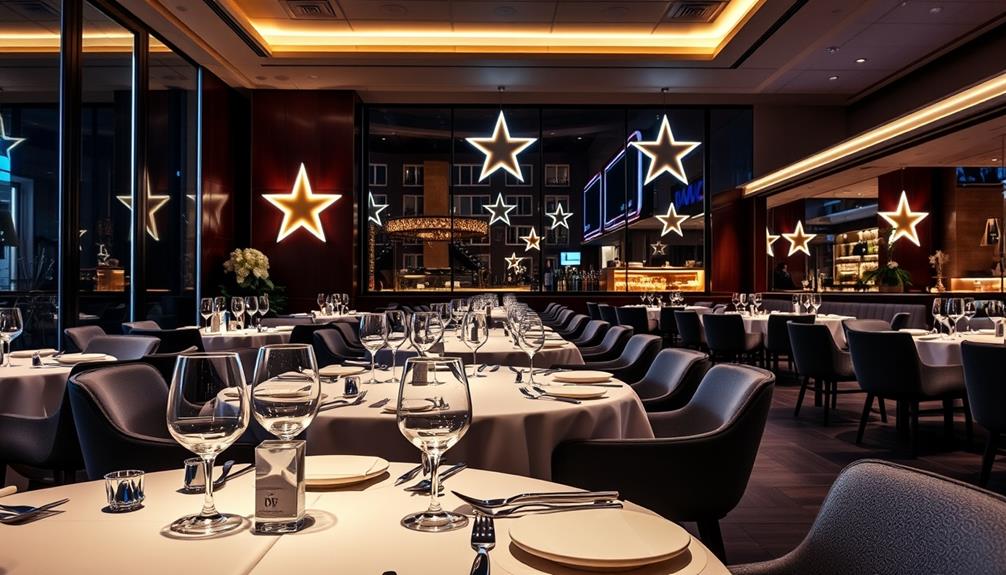
Michelin stars can dramatically enhance a restaurant's visibility, making it a hotspot for food lovers. With each star, you attract not just local patrons but also culinary tourists enthusiastic to experience top-tier dining.
This boost in recognition can lead to a surge in reservations and opportunities you mightn't have otherwise encountered. Additionally, the allure of a Michelin-starred restaurant often intertwines with cultural beliefs about excellence in cuisine, similar to how astrology and attractiveness can influence perceptions of charm.
The prestige associated with these stars can also enhance a chef's confidence and creativity, further elevating the dining experience.
Enhanced Restaurant Visibility
Restaurants that earn Michelin stars often see a remarkable boost in visibility, attracting attention from food enthusiasts and casual diners alike. The recognition not only elevates the establishment but also enhances the chef's reputation, leading to a surge in reservations and overall patronage.
This phenomenon can be likened to the way celebrity relationships and transformations capture public interest, as seen in the dynamics of Jennifer Aniston and Brad Pitt's friendly connection post-divorce.
Here are some key impacts of Michelin stars on restaurant visibility:
- Increased Reservations: Awarded restaurants typically experience a spike in bookings almost immediately after receiving stars.
- Exceptional Recognition: Three Michelin stars denote outstanding cuisine, making these venues worthy of a special trip.
- Chef Visibility: Starred chefs gain media attention, enhancing their profiles within the culinary community.
- Future Consideration: Restaurants featured in the Michelin Guide—even without stars—gain recognition, increasing their chances for future awards.
- Boost to Local Economies: The influx of diners to Michelin-starred restaurants can considerably benefit local businesses and tourism.
Ultimately, Michelin stars provide unparalleled visibility that can transform a restaurant's identity, drawing in a diverse clientele enthusiastic to experience exceptional cuisine.
Increased Culinary Tourism
The allure of dining at Michelin-starred establishments has sparked a surge in culinary tourism, enticing food lovers to travel far and wide for a taste of exceptional cuisine. When a restaurant receives Michelin stars, its visibility skyrockets, leading to a flurry of reservations and a new wave of travelers enthusiastic to indulge in fine dining experiences.
| Factors Influencing Culinary Tourism | Impact of Michelin Stars |
|---|---|
| Increased Visibility | More Reservations |
| Global Attraction | Travelers Planning Trips |
| Economic Growth | Boosts Local Economy |
The Michelin Guide considerably influences dining trends, highlighting local cuisines and overlooked culinary destinations. Starred restaurants often become key attractions, drawing visitors and enhancing a city's reputation as a culinary hotspot. This transformation encourages gastronomic tourism, where travelers seek out excellent cooking and unique dining experiences.
As you explore the world of culinary tourism, you'll find that Michelin stars not only elevate individual restaurants but also foster a vibrant culture of fine dining across regions. In doing so, they create a global community of food enthusiasts, all eager to savor the best that the culinary world has to offer.
Notable Three-Star Restaurants

Achieving three Michelin stars is a remarkable feat that signifies exceptional culinary excellence, and a handful of establishments truly stand out in this elite category.
With only 145 restaurants worldwide holding this prestigious rating in the 2024 Michelin Guides, you can expect extraordinary dining experiences worth a special journey. Not only do these restaurants offer exquisite dishes, but they also provide an ambiance and service level that rivals the best luxury cruise experiences, where every detail is meticulously crafted to enhance enjoyment, similar to luxury cruises providing exclusive amenities.
Here are some notable three-star restaurants that exemplify this level of exceptional cuisine:
- La Pergola in Italy, known for its breathtaking views and innovative Italian dishes.
- Aqua in Germany, celebrated for its creative seafood offerings.
- El Celler de Can Roca in Spain, famous for its unique take on Catalan cuisine.
- Alinea in Chicago, a pioneer in molecular gastronomy.
- L20, also in Chicago, noted for its exquisite seafood and artistic presentations.
Tokyo, the world's starriest city, showcases an impressive number of three-star restaurants, underlining the city's culinary excellence.
Additionally, Ana Roš's historic achievement as Slovenia's first three-star chef reflects the expanding global diversity in Michelin-starred dining.
These restaurants not only offer exceptional cuisine but also push the boundaries of culinary art, making them truly notable.
Trends in Michelin Ratings

Examining trends in Michelin ratings reveals a dynamic shift in the culinary landscape that's reshaping how we view fine dining. Today, Michelin stars signify more than just excellent cuisine; they reflect broader societal changes, such as the rise of female chefs and a commitment to sustainability.
You might notice that the Michelin Guide is now recognizing a more diverse range of restaurants globally. Cities like Toronto and Vancouver are gaining traction, boosting culinary tourism and showcasing their unique culinary cultures.
Here's a visual representation of these trends:
| Trend | Description |
|---|---|
| Increase in Female Chefs | More women are being awarded three stars, breaking barriers. |
| Geographic Diversity | Recognizing restaurants from varied locations worldwide. |
| Focus on Sustainability | Emphasizing local ingredients and eco-friendly practices. |
| Impact on Culinary Tourism | Cities see increased visitors drawn by Michelin-starred dining. |
With 145 restaurants now boasting three stars in 2024, the competition is fierce. As you explore this evolving landscape, you'll find that Michelin stars now hold greater significance than ever before.
Challenges of Michelin Recognition
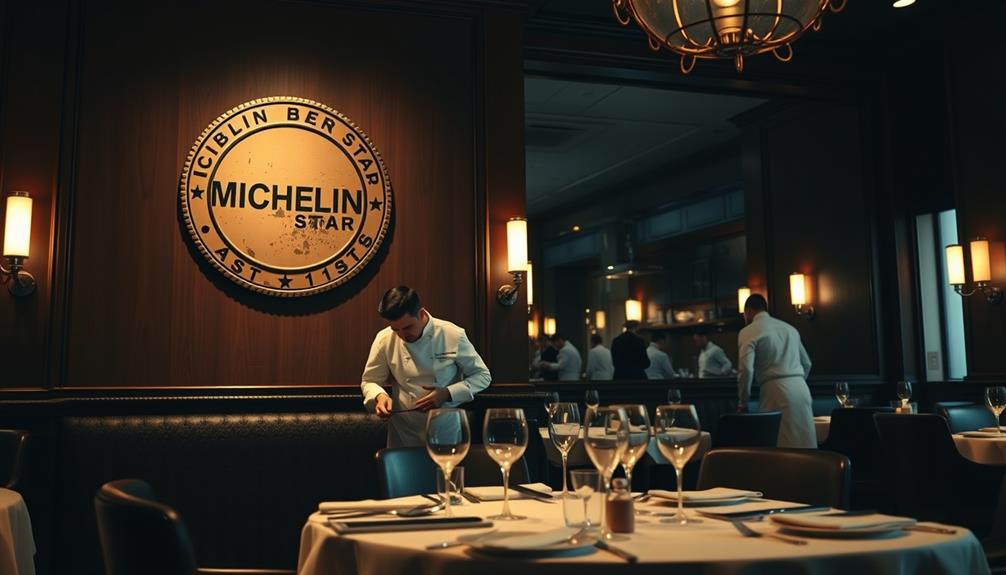
Maneuvering the world of Michelin recognition can be formidable for chefs and restaurateurs alike, as they face immense pressure to uphold consistently high standards.
This relentless pursuit of excellence brings several challenges that can stifle creativity and innovation in the kitchen. To navigate these challenges effectively, it's crucial to foster a culture of innovation and experimentation, much like the principles found in design thinking leadership.
Here are some key challenges you might encounter:
- Intense scrutiny: Michelin inspectors assess every detail, making it tough to maintain a relaxed atmosphere.
- High expectations: The pressure to deliver exceptional experiences during peak times can be overwhelming.
- Risk of losing stars: A single misstep could result in losing your hard-earned Michelin stars.
- Stiff competition: With only a limited number of stars available, many talented restaurants remain unrecognized.
- Impact on creativity: The focus on consistency can hinder chefs from experimenting with new ideas.
As you seek Michelin recognition, remember that while the rewards can be significant, the challenges are equally formidable.
Balancing the quest for stars with the desire to express your culinary creativity is a delicate act that requires perseverance and passion.
Frequently Asked Questions
Can You Get a 5 Star Michelin?
You can't get a five-star Michelin rating. The Michelin star system only allows up to three stars, which signify exceptional culinary experiences. Focus on achieving those three stars for the highest recognition in fine dining.
How Many Stars Can You Get in a Restaurant?
You can get up to three stars in a restaurant, reflecting different levels of culinary excellence. One star means it's very good, two stars indicate excellent cooking, and three stars represent exceptional cuisine worth a special journey. Michelin star restaurants count are not just about the food, but also take into account factors such as the skill of the chef, quality of ingredients, creativity, and consistency. It is quite an honor for a restaurant to receive even one Michelin star, as it signifies a high level of accomplishment in the culinary world. Michelin star restaurants count is a prestigious measure that represents the dedication and passion of the chefs and staff who work tirelessly to create memorable dining experiences for their guests.
Is It Possible to Get 4 Michelin Stars?
Imagine a night sky filled with shimmering stars, yet no constellation ever boasts more than three. You can't earn four Michelin stars; the heavens hold their limits, celebrating exceptional cuisine with a clear, guiding light.
How Many Stars Does Gordon Ramsay's Restaurant Have?
Gordon Ramsay's flagship restaurant in London has three Michelin stars, showcasing its exceptional cuisine. You can expect an unforgettable dining experience there, as it's consistently recognized as one of the finest establishments in the world.
Conclusion
In the world of dining, Michelin stars are the golden tickets to culinary prestige. Whether you're dreaming of a cozy one-star haven or an extravagant three-star experience, each level offers its own unique charm. While the journey to recognition can be tough, it's a delicious challenge that rewards both chefs and diners alike. So, keep your forks ready and your palates enthusiastic—you never know when you might stumble upon your next star-studded meal!
